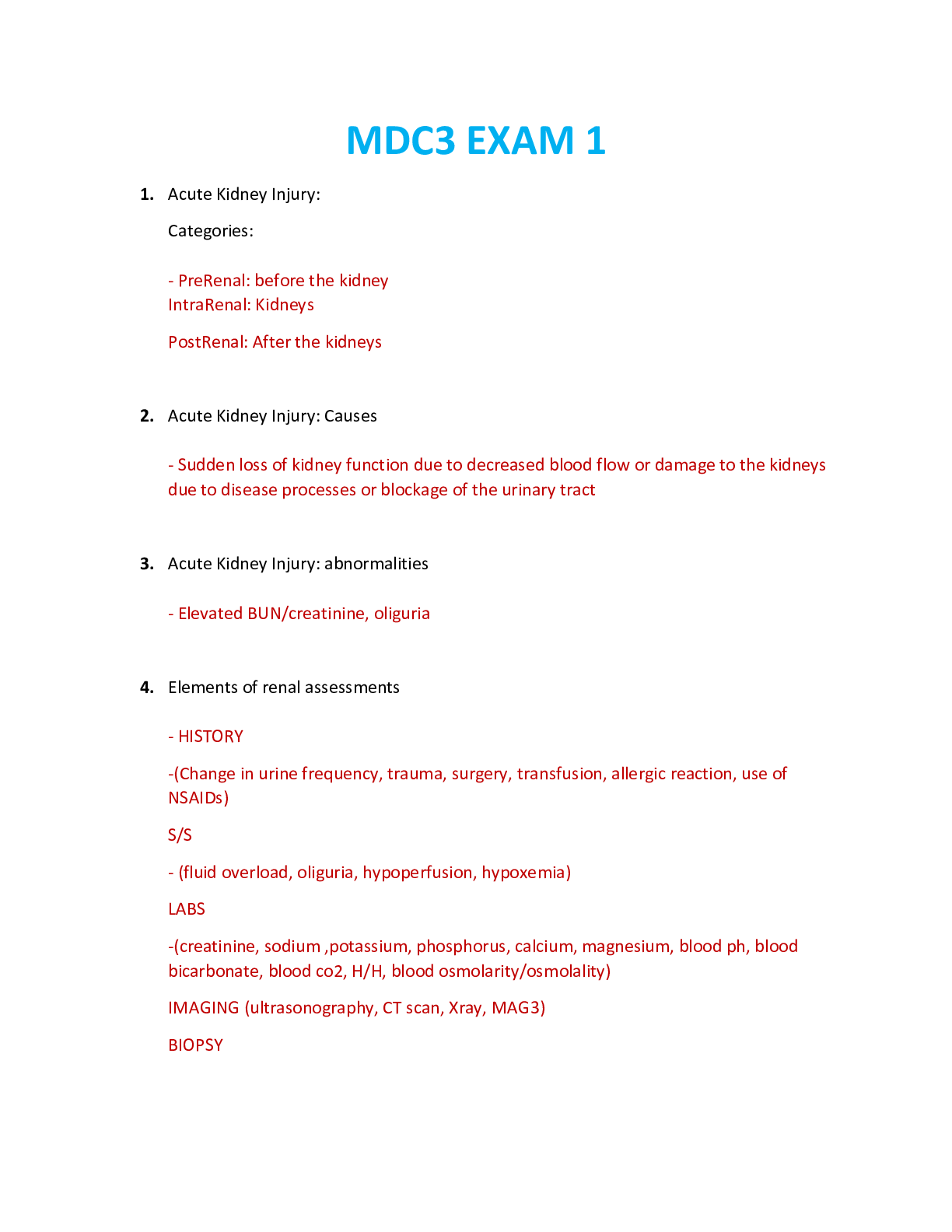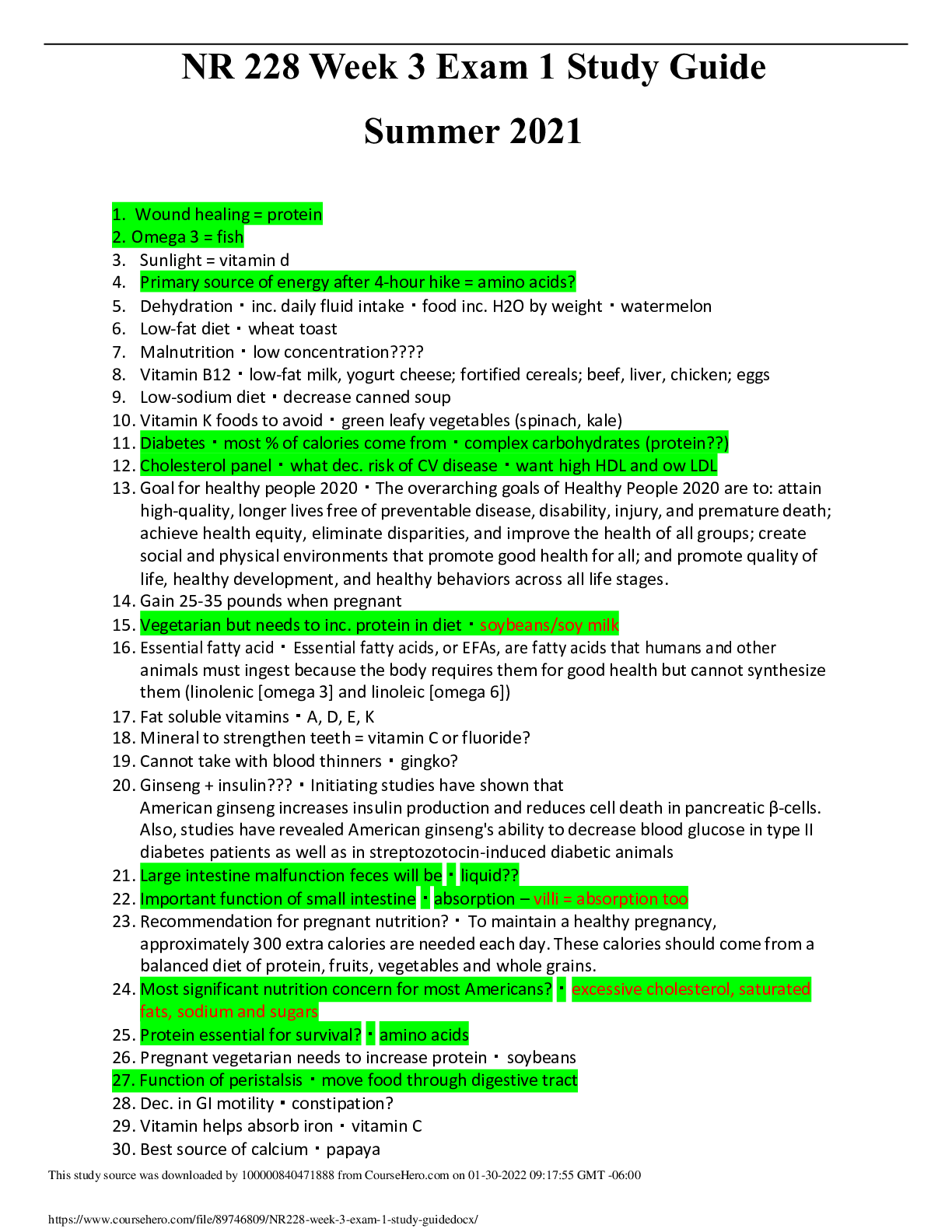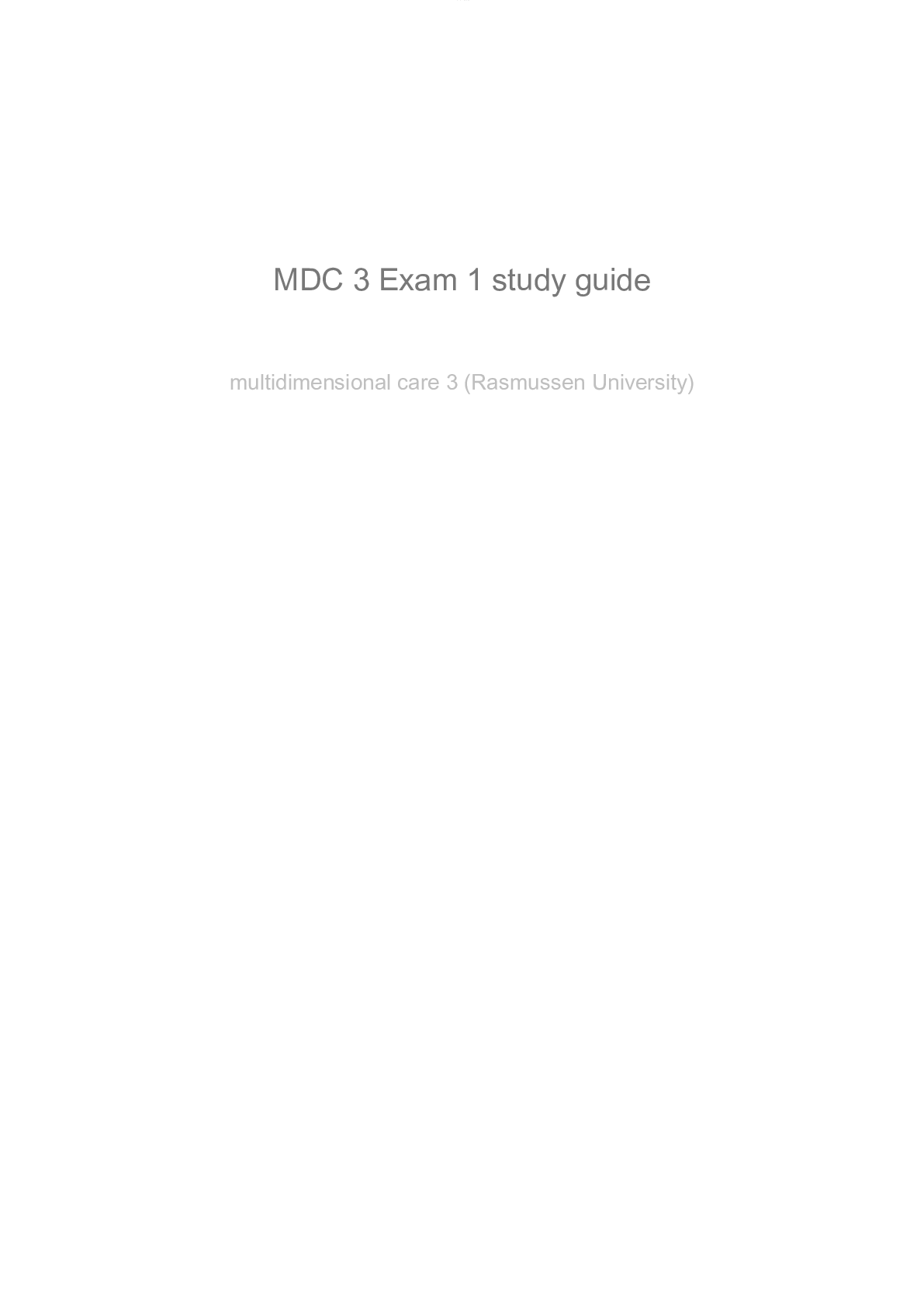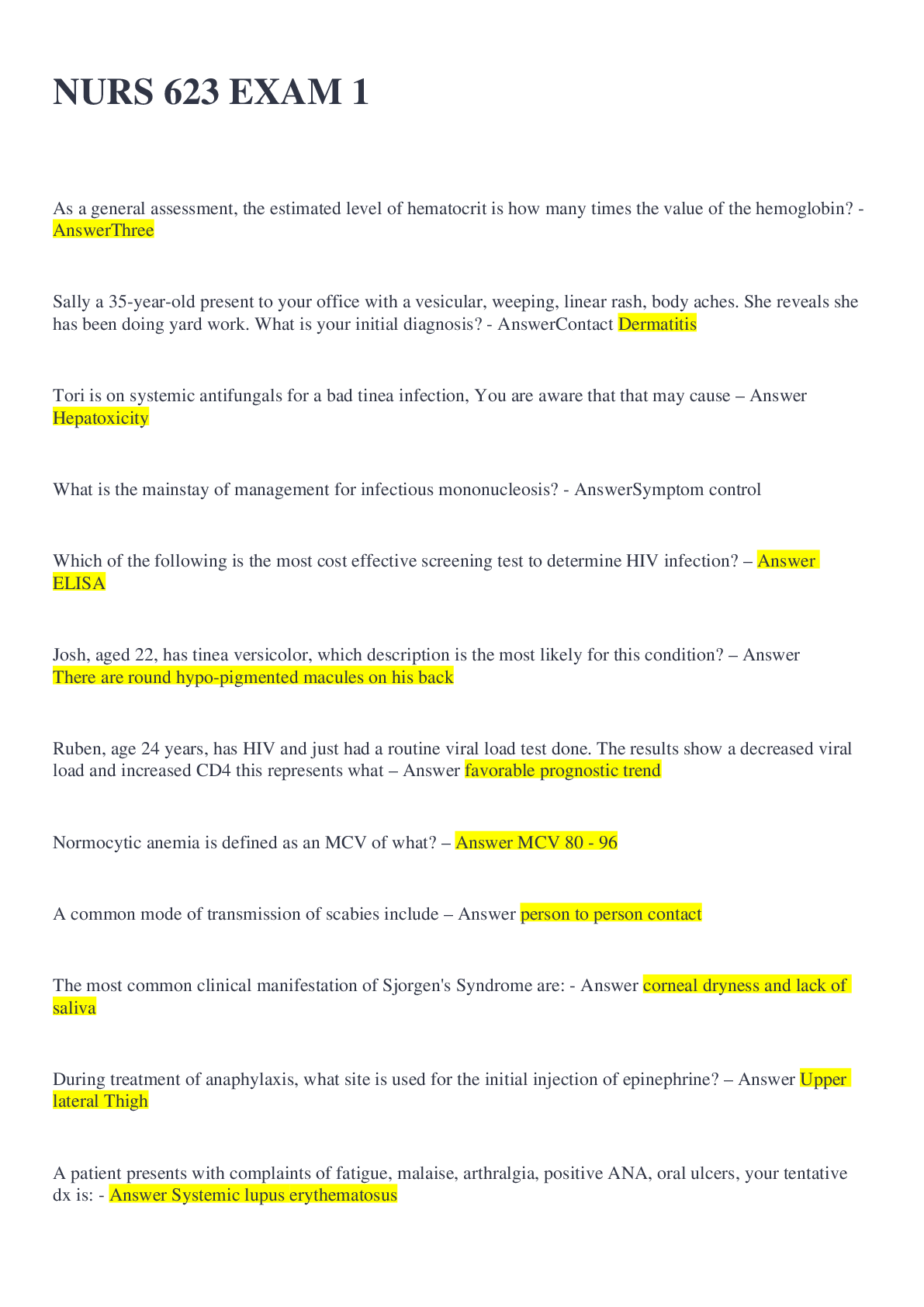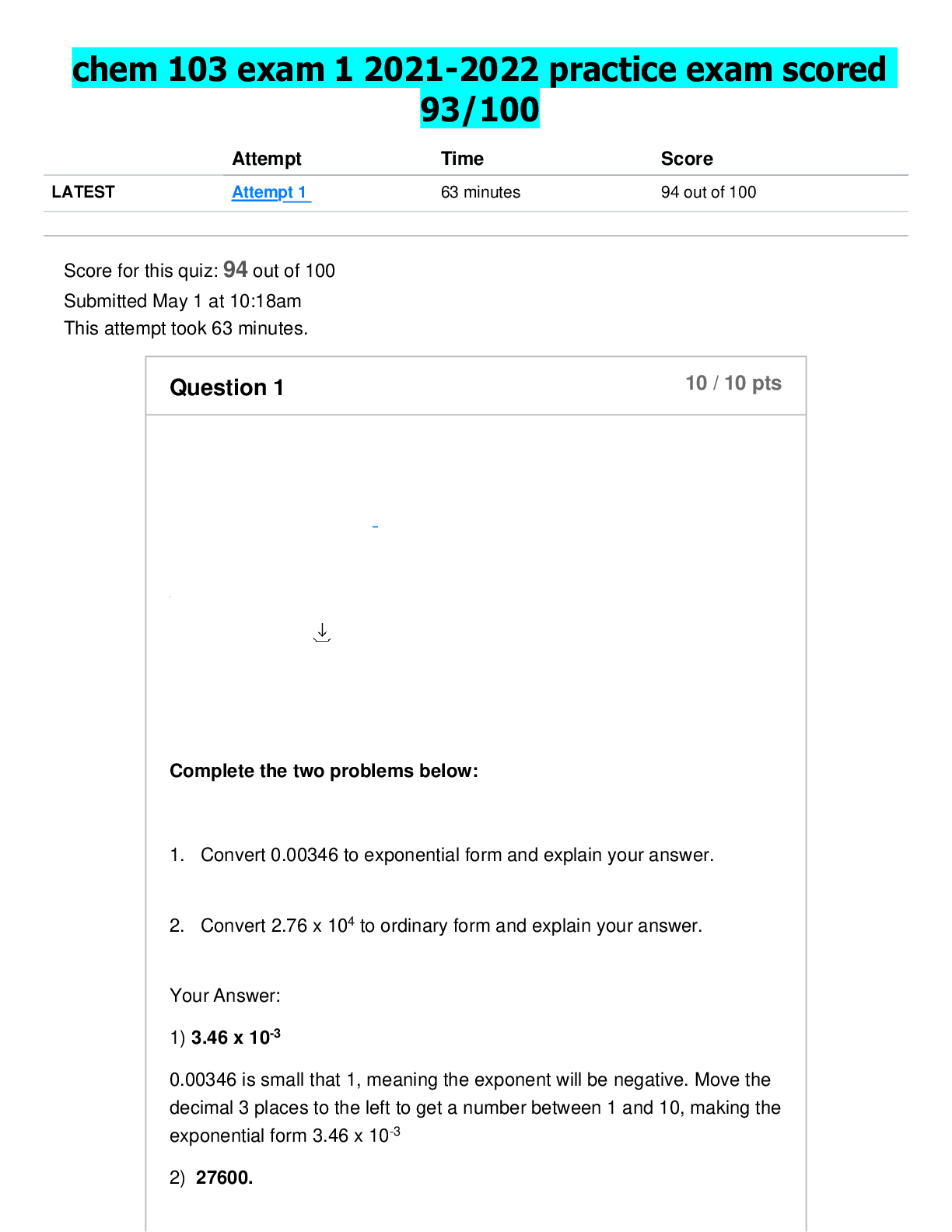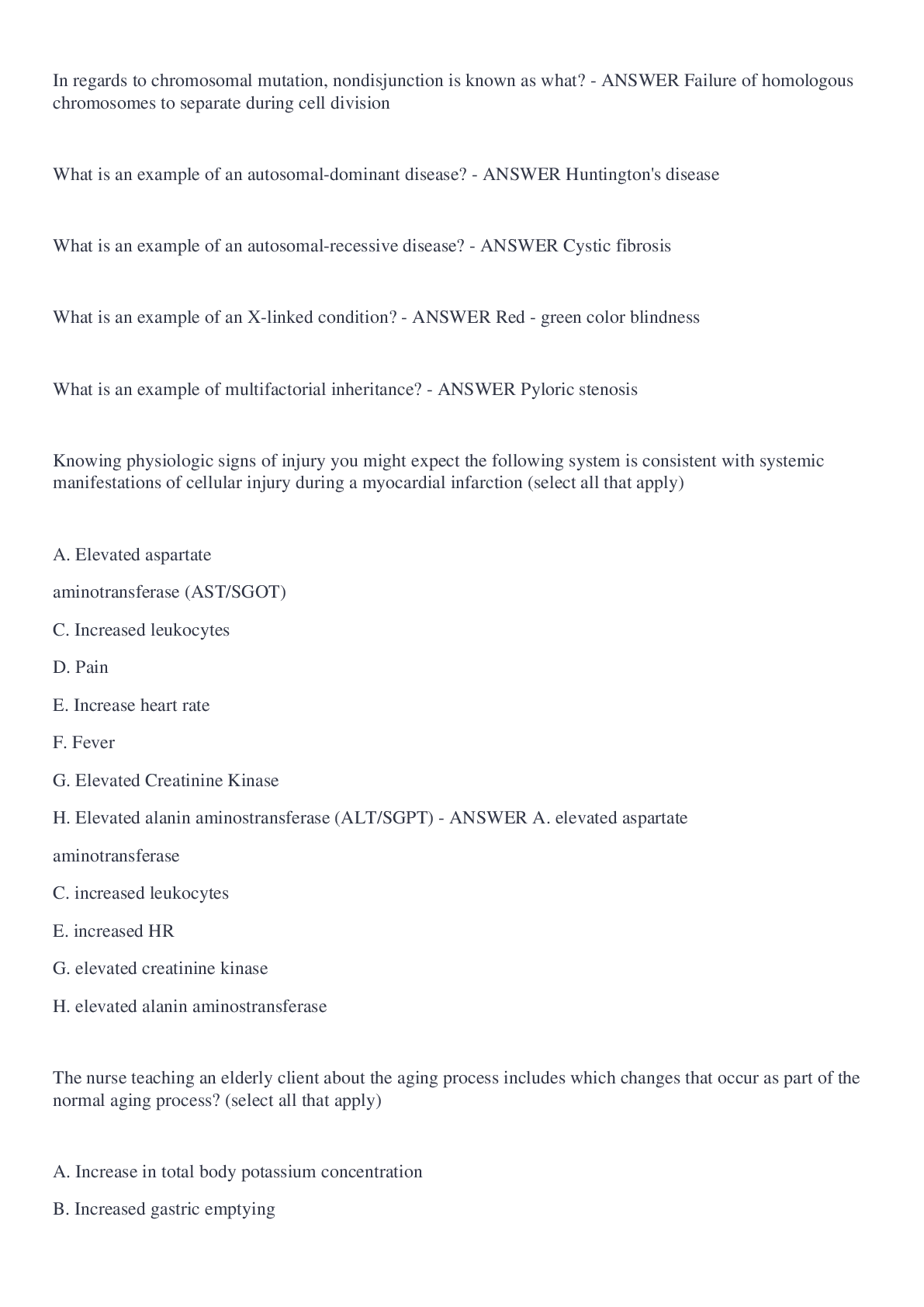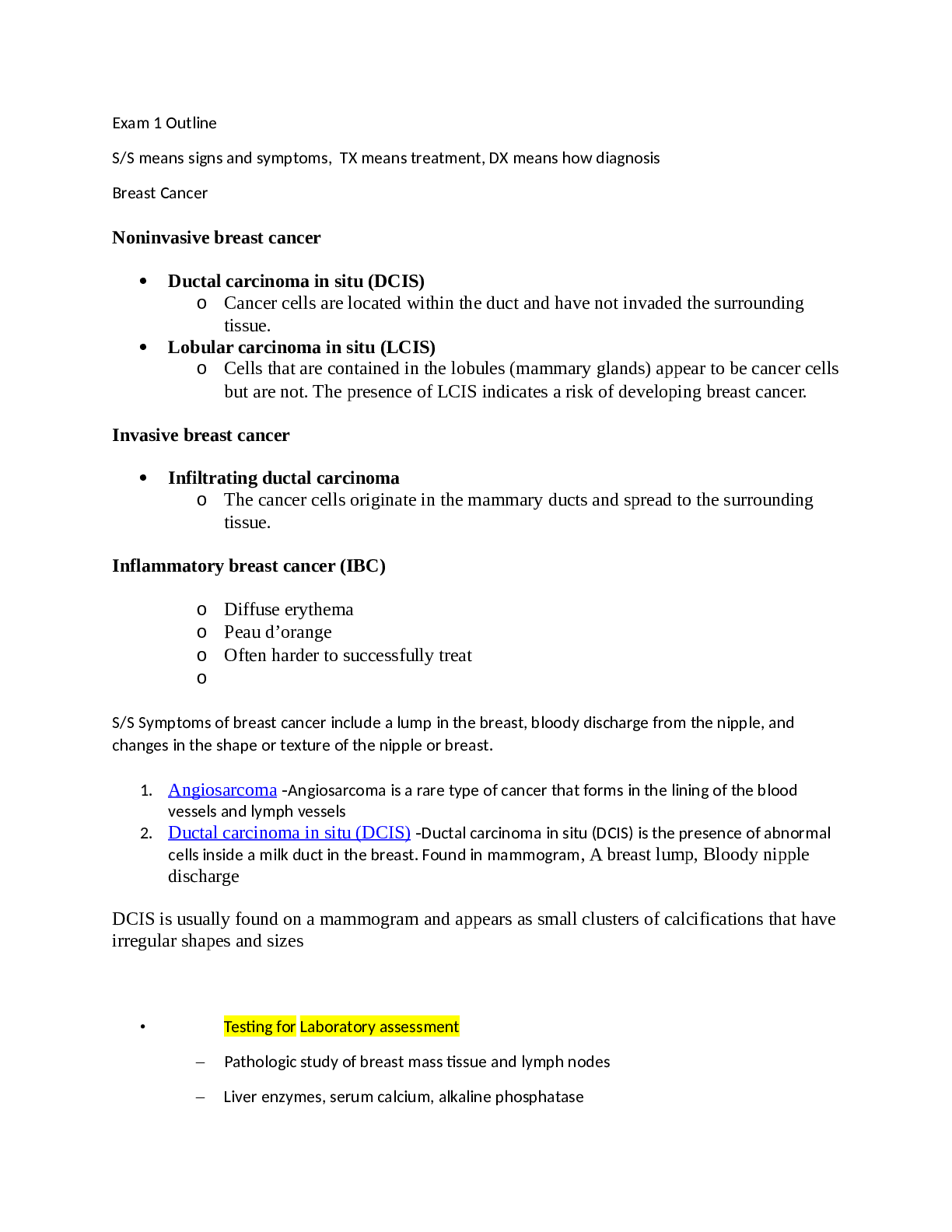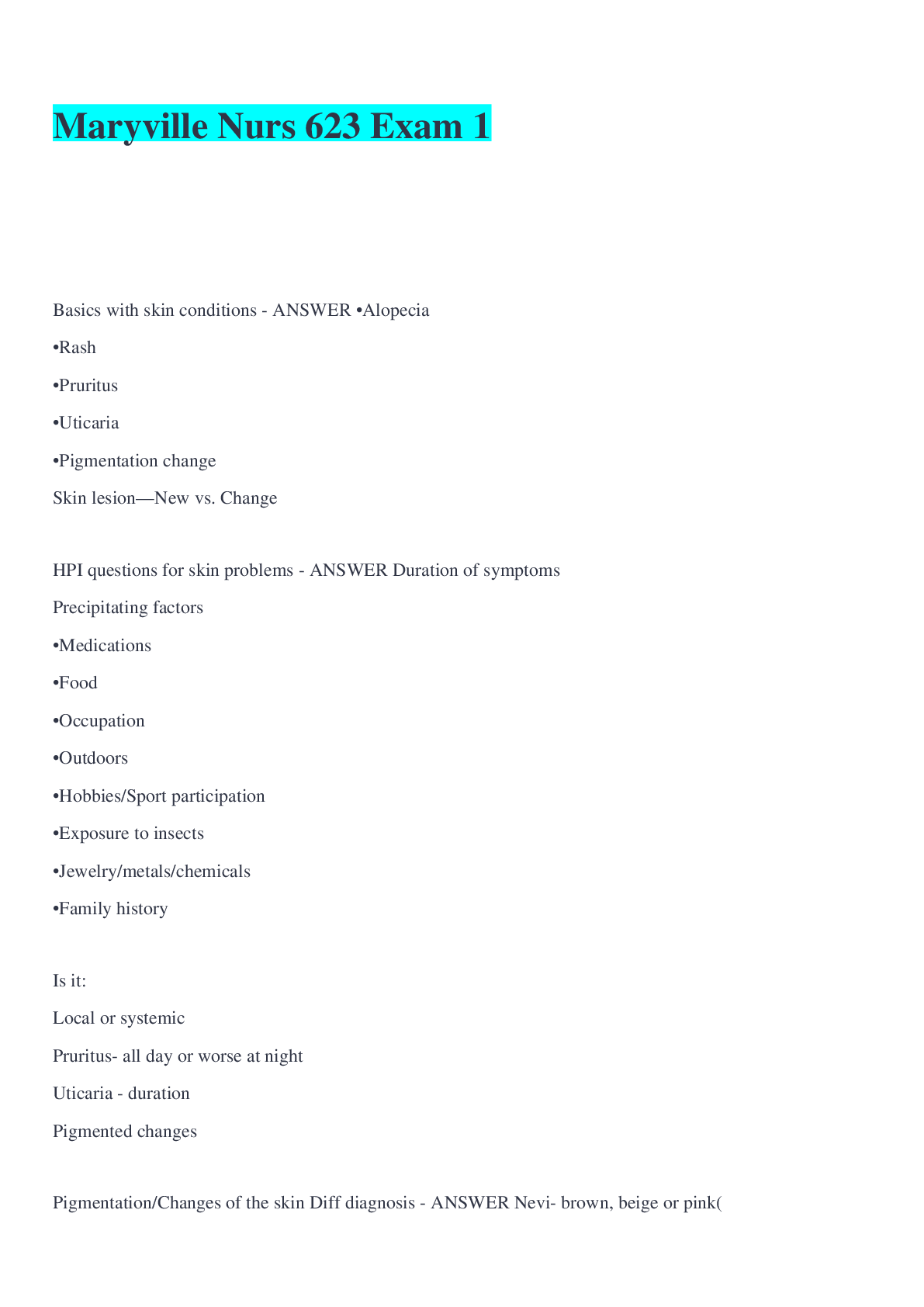ATI Pharm 3 Exam 1 guide solution 2021 newly updated docs
Document Content and Description Below
ATI Pharm 3 Exam 1 guide solution 2021 newly updated docs 1.HCP caring for a patient taking zolipidem (ambien). Patient has a history of benzodiazepine abuse and reports insomnia. The HCP should c... aution the patient that this drug can cause. Memory impairment (retrograde amnesia) Particularly an inability to recall activities patients carry out just before or during sleep. Diplopia (double vision) Unlikely to occur with this medication Constipation More common with drugs that treat muscle spasms (baclofen) Headache and myalgia (muscle pain) Unlikely to occur with this medication 2. Memantine (Namenda) for AD. HCP should include which of the following instructions.. Increase in fluids It isn’t necessary to increase fluids. Patients excrete drug normally through urine, fluid intake doesn’t affect process Eliminates AD manifestations Can help slow down progression of AD, but will not eliminate manifestation Use cautiously with patients who have severe liver impairment Antacids that contain sodium bicarb increase urine alkalinity and can decrease drug excretion, ultimately leading to toxicity 3.Patients taking selegiline (elderpryl) to treat PD. Provider is considering use of analgesic for patient but should be aware that a drug interactions between selegiline and meperdine (Demerol) can result in Doesn’t cause frequent urination Doesn’t cause jaundice Liver toxicity is a serious adverse effect of dantrolene (Dantrium) and many anticonvulsants, such as valproic acid (Depakote) Unlike to result in oral ulcers Skin inflammation is a serious adverse effect of some anticonvulsants such as phenytoin (Dilantin) Drug interactions between seleginine and opioids Results in rigidity, stupor, agitation, hypertension and fever 4. HCP caring for a patient taking Dantolene (Dantrium) for skeletal muscle spasms. Which lab test requires monitoring? Liver function Liver toxicity is a serious adverse effect. HCP should monitor liver function prior to treatment and at regular intervals, and advise patients to report jaundice or abdominal pain. Serum Potassium Hydrochlorothiazide is drug that can alter potassium levels. Serum Sodium Hydrochlorothiazide is drug that alter sodium levels. Thyroid Function Interferon alfa preparations are drugs that can alter thyroid function 5. HCP is talking to a patient who is about to begin taking valproic acid (Depakote) for a newly diagnosed seizure disorder. Adverse effect patient should report to provider? Drowsiness Patients taking valproic acid should report CNS depressant effects, such as a sedation or drowsiness, b/c these effects can indicate the need for a reduction in dose. Headache Valproic acid can cause HA, along c other CNS adverse effects, such as sleep disturbances. Rash Skin rash is a side effect of valproic acid and other antiepileptic drugs. Ataxia Side of phenytoin ( Dilantin) and carbamazepine (Tegretol), both used to treat seizures disorders Hirsutism Valproic acid is more likely to cause hair loss than hirsutism (excessive hair growth) 6.Patient taking temazepam (Restoril). Instructions provider should include? Take the drug 30 min before bedtime Patients should take temazepam 30 min before bedtime to improve sleep and to prevent daytime drowsiness. Avoid alcohol and other depressants Temazepam can cause CNS depression. Combined use with alcohol or other depressants can cause severe respiratory depression. Taper the drug slowly to prevent withdrawal symptoms Abrupt discontinuation of temazepam can cause withdrawal symptoms. Patients should taper the drug slowly to prevent or minimize withdrawal. Wear sunscreen and protective clothing Although all patients should protect their skin from sun exposure, temazepam is unlikely to make patients any more vulnerable to damage from ultraviolet radiation. Phenothiazines, such as chlorpromazine, can cause photosensitivity. Increase fiber and fluid intake Temazepam is more likely to cause diarrhea than constipation. Tricyclic antidepressants can cause constipation. 7. HCP should monitor patient who is taking donepezil (Aricept) for AD? Nausea Most common adverse effect donepezil (Cholinesterase inhibitor) are nausea, vomiting, and diarrhea. Taking the drug with food can help minimize adverse effects. Confusion Donepezil can improve memory, thinking, and reduce confusion. Dry mouth Muscarinic antagonist can cause dry mouth. Double vision Donepezil, is more likely to cause blurred vision than double vision. 8. HCP is talking to a patient about beginning sumatriptan (Imitrex) therapy to treat migraine headaches. HCP should advise the patient to watch for which of the following adverse effects? Chest Pain Sumatriptan (Serotonin agonist) can cause coronary vasospasm and chest pain. Patients should report any pressure, pain, or tightness in the jaw chest or back. Sumatriptan is not an appropriate choice for patients who have a history of CAD. Polyuria Sumatriptan is unlikely to cause polyuria. Lithium carbonate can cause polyuria. Joint pain Sumatriptan is more likely to cause muscle pain than joint pain. Insomnia Sumatriptan is unlikely to cause insomnia. It can cause drowsiness and sedation. 9. HCP is talking to a patient who is newly diagnosed with PD about how levodopa/carbidopa (Sinemet) will help control her symptoms. Which of the following mechanism is the drug effective in treating the disorder? Increase available acetylcholine in the brain Decrease available acetylcholine in the extrapyramidal system of the brain. Inhibits norepinephrine metabolism in the brain Altered levels of cerebral norepinephrine can correlate with depression. Inhibits serotonin metabolism in the brain. Altered levels of cerebral serotonin can correlate with depression. Increases available dopamine in the brain. Levodopa/carbidopa, can act by increasing dopamine in the extrapyramidal center of the brain, reducing involuntary motion. 10. Patient newly diagnosed seizure disorder. Patient is taking both valproic acid (Depakote) and phenytoin (Dilantin). HCP should recognize that which of the following can occur as result of drug interactions between valproic acid and phenytoin? Hyperammonemia Unlikely from a drug interaction between valproic acid and phenytoin. Taking valproic acid with topiramate (Topamax), however, can increase the risk of excess ammonia in the blood. Phenytoin toxicity Valproic acid can cause an increase in phenytoin blood levels, causing phenytoin toxicity. The primary care provider should monitor serum phenytoin levels and reduce the dosage if levels begin to exceed the therapeutic range. Hypertension Unlikely from drug interaction between valproic acid and phenytoin. PUD PUD is unlikely from a drug interaction between valproic acid and phenytoin. Taking cimetidine (Tagamet) with phenytoin, however, can increase phenytoin levels. 11. HCP talking to a patient and family about how methylphenidate (Ritalin) will help manage ADHD. Which of the following therapeutic effects should they expect? Reduced panic SRRI such as fluoxetine (Prozac) reduce panic. Improved mood Mood stabilizers, such as Lithium (Lithobid) treat depression and improve mood. Increased focus Simulants such as methylphenidate, regulate levels of dopamine and norepinephrine in the brain to produce calmness, reduce hyperactivity, and increase focus for patients who have ADHD. Decreased anxiety Sedative-hypnotic drugs such as lorazepam (Ativan) treat anxiety. 12. Patient taking modafinil ( Provigil) to treat narcolepsy, which of the following instructions should the HCP include? Take the drug in the morning Modafinil is a non-amphetamine stimulant. Taking it in the morning helps improve wakefulness for patients who have narcolepsy. Patients taking the drug for shift-work sleepiness should take it 1 hour before work. Take the drug 30 min before bedtime Modafinil is a non-amphetamine stimulant. Evening dosage can cause insomnia. Zolpidem (Ambien) is a drug patients should take just before bedtime to improve sleep and to prevent daytime drowsiness. Anticipate daytime drowsiness Modafinil is non-amphetamine stimulant that promotes wakefulness. It is unlikely to cause daytime drowsiness. Eszopiclone (Lunesta) is a drug that can cause daytime drowsiness. Expect urinary frequency Modafinil is a non-amphetamine stimulant. It is unlikely to cause urinary frequency, although it can cause diarrhea. 13. HCP is caring for a patient who is about to begin taking amphetamine sulfate (Adderall). HPC should monitor the patient for which of the following adverse effects? Hypotension Amphetamine sulfate is a stimulant. It is more likely to cause hypertension. Tinnitus It can cause irritability and insomnia. Tachycardia It can cause tachycardia and dysrhythmias. Patients should notify the HCP if they develop palpitations or chest pain. Bronchospasm It is unlikely to cause bronchospasm, but it can cause diarrhea and nausea. Taking the drug with food helps reduce these effects. 14. Which finding should alert a HCP that a patient is developing a potentially serious adverse reaction to interferon beta-1b (Betaseron)? Tinnitus Tinnitus isn’t a typical adverse reaction to interferon beta-1b. However, tinnitus is common with aspirin therapy. Twitching eyelids Eyelid and muscle twitching can be a sign of toxicity of some anticonvulsants. It isn’t a typical adverse reaction to interferon beta-1b. Blue-green skin discoloration Interferon beta-1b can cause skin, sclera, and urine to turn a blue green color. Fatigue B/c of the potential for bone marrow suppression and decrease platelet count, patients should report unexplained bruising, bleeding or fatigue. 15. HCP administer fentanyl (sublimaze) to a patient to reduce pain. Which of the following drugs should she have available to reverse the effects of fentanyl? Neostigmine (Bloxiverz) Cholinesterase inhibitor. Reverses the effects of pancuronium, a nondepolarizing neuromuscular blocking agent. Succinylcholine (Anectine) A depolarizing neuromuscular blocking agent that will cause increased muscle relaxation. Naloxone A opioid antagonist that reverses the effects of opioid. Fentanyl, an opioid agonist, can cause severe respiratory depression. HCP administering fentanyl should also have resuscitation equipment available. Dantrolene (Dantrium) Skeletal muscle relaxant that treats malignant hyperthermia and spasticity. 16. HCP caring for a patient who is taking dantrolene (Dantrium) for skeletal muscle spasms. HCP should tell the patient to report which of the following adverse effects? Slow pulse rate Dantrolene is more likely to cause tachycardia. Cough Dantrolene can cause difficult swallowing. Diarrhea Prolonged diarrhea can cause dehydration and other serious effects. Diarrhea is an adverse effect of dantrolene, as are nausea and vomiting. Patients should report these effects so the HCP can monitor fluid balance and intervene accordingly. Hearing Loss Dantrolene can cause blurred vision, but it unlikely to cause hearing loss. 17. B/C of the potential for adverse effects, which of the following should HCP recommend for patients who begin taking carbamazepine (Tegretol). Begin taking the drug at a low dosage Visual disturbances, vertigo, and ataxia can result from taking carbamazepine, an iminostilbene that treats seizure disorders. Dosages should be low to minimize or prevent these adverse effects. Discontinue the drug immediately if diarrhea occurs As with any drug that control seizures, stopping it abruptly can make seizure activity return and possibly even trigger status epilepticus. Carbamazepine, an iminostilbene, can cause diarrhea. If diarrhea does develop, a better alternative is to treat the diarrhea and see if it resolves as drug therapy with carbamazepine continues. Have serum glucose levels checked regularly. Not likely to alter glucose levels. However alter liver function. Take the drug on an empty stomach. Taking carbamazepine, which meals can help prevent GI upset and can enhance absorption. 18. HCP is talking to a patient who is to begin taking valproic acid (Depakote) to treat a seizure disorder. He should advise the patient to monitor for which of the following adverse effect? Hirsutism Unlikely to cause hirsutism or excessive hair growth, although it can cause transient hair loss. Depression Unlikely to cause depression, although it can cause aggression. Jaundice Valproic acid can cause hepatic toxicity, characterized by jaundice , abdominal pain and nausea. Patients taking the drug should report these symptoms and HCP should monitor liver function studies prior to treatment and periodically during therapy. Gum irritation Valproic acid is unlikely to cause gum irritation. Phenytoin (Dilantin) can cause gingival hyperplasia. 19. Which of the following info should a HCP include when talking to a patient about taking baclofen (Lioresal)? Avoid driving until the drug’s effects are evident Baclofen, a centrally-acting muscle relaxant, causes CNS depression. Patients taking the drug should avoid alcohol and other CNS depressants and shouldn’t drive a vehicle until they know how the drug will affect them. Stop taking the drug immediately if headache occurs Abrupt withdrawal of baclofen, can cause seizures, fever and hypotension. A better alternative is a treat the headache, which can have many other causes, and see if it resolves as drug therapy with baclofen continues. Take the drug as needed for spasticity. Patients typically take baclofen, daily at regular doses. Patients should start with low dose and titrate up as tolerated. Take the drug with antacids to reduce gastric effects. Patients may take baclofen, with food to help prevent nausea. They should take antacids 1 hr before or 2 hr after other drugs. 20. HCP is caring for a patient who receiving thiopental (Pentothal). For which of the following should the HCP monitor? Cardiac excitability Short acting barbiturate can cause cardiovascular depression. It is essential to have CPR equipment available whenever patients receive the drug. Respiratory depression Short acting barbiturate causes respiratory depression. Mechanical vent and continuous monitoring are essential for patients receving the drug. Hyperthermia Causes hypothermia Hypotension Doesn’t cause risk significant risk for hypotension. 21. HCP is talking to a patient about adverse effects of interferon beta-1a (Avonex). To help minimize these effects, she should tell the patient to Premedicate with acetaminophen (Tylenol) Causes fever, chills, headaches, and muscle aches. Acetaminophen or NSAID can help minimize these symptoms. Take the drug with food Route of administration of interferon beta drug are IM/ SC Increase fluid intake Increasing fluid intake won’t help relieve the adverse reactions of interferon beta drugs. Take the drug in the morning. Evening administration of interferon beta drugs promotes tolerance of adverse reactions. 22. Anesthetics often administer midazolam (Versed) during induction of anesthesia because of which of the following pharmacologic actions? Produces analgesia Midazolam (Benzo) doesn’t cause analgesia. It causes headaches. Induces muscle paralysis Midazolam a benzodiazepine, don’t cause muscle paralysis. Neuromuscular blocking agents cause muscle paralysis. Dries secretions Midazolam doesn’t dry up secretions. Atropine is a drug that dries up secretions. Causes Amnesia Is an appropriate during induction because of its antianxiety and amnesiac properties. 23. An anesthetist is about to administer Lidocaine (xylocaine) as part of the protocol for spinal anesthesia for a patient who is undergoing a surgical procedure. The HCP should be aware that the patient could develop which of the following potentially serious effects? Tachycardia Most likely cause bradycardia when systemically absorbed than bradycardia. Hypotension Systemically absorbed in sufficient amounts, lidocaine, a local anesthetic, can cause hypotension, particularly when used as spinal anesthesia. Hyperthermia Lidocaine is unlikely to cause hyperthermia. It can cause excessive sweating. Hemoptysis Unlikely to cause hemoptysis or coughing up blood. It can cause respiratory depression with excessive systemic absorption. 24. A HCP is caring for a patient who is about to begin taking pramipexole (Mirapex) to treat PD. The HCP should recognize that which of the following lab test require monitoring? C-reactive protein Pramipexole (Direct acting dopamine receptor agonist) unlike to alter c-reactive protein. Pravastatin (Pravachol) is a drug that alters c-reactive protein in a beneficial way to help lower the risk of heart disease. Creatinine Phosphokinase (CPK) CPK is an enzyme found in the heart, brain, and skeletal muscles. Patients taking pramipexole can develop muscle weakness with a lack of energy, creating a situation that can be more problematic for patients than their original muscle dysfunction. Monitoring CPK can alter HCP to the possibility of skeletal muscle damage from the drug. Thyroid Function Unlike to alter thyroid function. Amniodarone (Cordarone) is a drug that can alter thyroid function. CBC Unlikely to alter CBC. Interferon beta-B (Betaseron) an immunomodulator can cause myelosuppression and warrants monitoring CBC’s periodically. 25. A HCP should include which of the following instructions when talking with a patient about taking levodopa/carbidopa (Sinemet) to treat PD? Change position slowly to prevent orthostatic hypotension Levodopa/carbidopa can cause orthostatic hypotension Eat a protein snack to increase absorption High protein foods can reduce the effectiveness of levodopa/ carbidopa. Taking levodopa/carbidopa with non-protein sources of food, however, can help reduce adverse GI effects. Take the drug at bedtime to avoid daytime drowsiness. Patients typically take levodopa/ carbidopa in divided doses during the day. Expect eye twitching to develop with long-term therapy Muscle twitching can indicate drug toxicity. This an adverse effect patients should report. Drill-1 Which of the following lab test should you monitor for a patient who is taking interferon beta-1b (Betaseron) to treat multiple sclerosis? Liver function test and CBC Interferon beta-1b, an immunosuppressant, may cause hepatotoxicity and myelosuppression. Monitor liver studies and CBC. This drug is unlikely to alter serum osmolality or glucose or thyroid hormone levels, but it can elevate serum creatinine and alter serum electrolyte. Drill-2 While obtaining a patients med. History, you find that the patient is taking levodopa/carbidopa (Sinemet) for PD. Which of the following info in the patients health hx alerts you to take further action? Glaucoma Combo can cause change in intraocular pressure. Providers shouldn’t prescribe this drug combo for patients who have glaucoma and in this cause, the patients drug therapy requires adjustment. Pancreatic disorders are not a contraindication; instead caution is required when using it with patients who have PUD. Hearing impairment isn’t a contraindication for levodopa/carbidopa; instead it can cause a variety of vision disturbances. Drill-3 Older adult patients partner reports that the patient has nausea, diarrhea and a loss of appetite. He has a hx of AD and is taking donepezil (Aricept). The provider should advise which of the following? Take the drug with food Cholinesterase inhibitor such as donepezil commonly causes N/V, anorexia and other GI symptoms. This is d/t the increase of acetylcholine in all parts of the body and its subsequent effect on the GI tract and other systems of the body. The provider should explain to the patient and his caregiver that taking the drug with food and at bedtime will help minimize uncomfortable GI effects. The provider also should instruct the partner to report vomiting, severe diarrhea, weight loss, or signs of GI bleeding, such as dark stools, coffee ground emesis, especially if the patient is also taking NSAID drug. At this point it is not necessary to stop taking the drug, reduce the dosage, or undergo liver function tests. Drill-4 Patient who has MS is taking dantrolene to help control spasticity. Through which of the following pharmacologic actions is this drug effective in treating this manifestation? Alters intracellular calcium exchange at the muscles Dantrolene, peripherally acting muscle relaxant, acts directly on spastic muscles and inhibits muscle contraction by preventing the release of calcium in skeletal muscles. Anticholinergic drugs or muscarinic antagonist block acetylcholine at the neuromuscular junction. Baclofen (Lioresal), a centrally acting muscle relaxant relieves spasticity by interrupting nerve signals from the spinal cord. Most drugs used to treat myasthenia gravis act by preventing the destruction of acetylcholine at the neuromuscular junction. Drill-5 HCP is caring for a patient who is preoperative and is NPO. The patient takes carbamazepine (tegretol), 200 mg PO BID for a seizure disorder. Which of the following actions should you take? Give the oral dose with a sip of water It is important to continue the oral carbamazepine to maintain therapeutic blood level and to prevent seizure activity. You should notify the anesthesiologist and should give the patient the carbamazepine with a sip of water. Carbamazepine isn’t available IV. Withholding the carbamazepine may reduce the therapeutic blood level and can cause seizure activity. Administering a reduced dose of carbamazepine may reduce the therapeutic blood level and cause seizure activity. Drill-6 School-age child and parents are to start the use of amphetamine-dextroamphetamine (Adderall) to manage the child with ADHD. You should tell the child and parent to watch for which of the following? Weight Loss/ Insomnia/ Hallucinations Amphetamine-dextroamphetamine, CNS stimulant, can lead to weight loss. Patients should take drug right before meals and maintain healthful eating habits. Amphetamine-dextroamphetamine can cause insomnia and restlessness, so patients should take the drug in the morning. It can cause paranoid psychosis, thus patients should report delusions, hallucinations, and changes in mood. Risperidone (Risperdal), an atypical antipsychotics drug, is likely to cause orthostatic hypotension. Atomoxetine (Strattera) may cause liver injury. Patients taking atomoxetine should report signs of liver injury such as flu-like symptoms, yellowing skin and abdominal pain. Drill-7 Hydantoin—Control Seizures Immunomodulator—Reduces symptoms of MS Cholinesterase Inhibitors—Helps minimize symptoms of AD Dopamine Receptor Agonist—Reduce effects of PD ATI Explanation The hydantoins control tonic-clonic seizures as well as partial seizures. They act by decreasing the neuronal activity of seizure generating cells in the brain by inhibiting the influx through sodium channels. Immunomodulators help reduce the symptoms of MS. They seem to inhibit the movement of leukocytes, which are produced as a part of the body’s defective autoimmune response, and thus protect the myelin sheath of neurons from their damaging effect. Cholinesterase inhibitors help improve cognitive function in patients with mild to moderate AD, thus minimizing symptoms. They increase the amount of acetylcholine available and thus counteract the acetylcholine depletion that characterizes AD. Dopamine receptor agonist, also known as monoamine oxidase or MAOI’s are one of the type of drugs used to control the symptoms of PD. Dopamine replacement drugs are another drug classification that compromises pharmacologic therapy for PD. These drugs either mimic the action of dopamine or make more of it available and thus counteract the dopamine depletion that characterizes PD. Drill-8 A PCP prescribes sumatriptan (Imitrex) to treat a patient’s migraine headaches. Which of the following instructions should you include when telling the patient how to take sumatriptan? Take the drug after onset of the migraine Repeat the dose once if the headache is not relieved Patient should only take sumatriptan, a serotonin agonist, after the onset of a migraine or cluster headache. They should spray the drug once into one nostril. They may repeat the dose once, 1 to 2 hours after the initial dose, depending on the route. They shouldn’t use sumatriptan sublingually; only PO, sublingual, and intranasal routes are appropriate. Drill-9 A patient receives a spinal anesthesia with lidocaine (xylocaine) and epinephrine (adrenaline). You explain that epinephrine is used with lidocaine for which of the following reasons? Prolongs the anesthetic effects Injecting epinephrine with lidocaine for local and regional anesthesia extends the duration of the regional anesthesia. Epinephrine will not reduce the risk for a spinal headache. Instead, positioning patients supine can reduce headaches. Epinephrine has no effect on infection risk. It is essential for anesthetist to confirm correct drug concentration and correct spinal placement to prevent drug toxicity and to monitor for paresthesia, confusion, agitation which can lead to seizures and respiratory arrest. Injecting epinephrine into the subarachnoid space with not prevent respiratory depression. A spinal anesthetic that involves the intercostal muscles can cause respiratory depression. Should this occur, it is critical to monitor spinal level, administer supplemental oxygen, and provide respiratory support as needed. Drill-10 Dantrolene (Dantrium) – Malignant hyperthermia Amphetamine/Dextroamphetamine sulfate (Adderall)—ADHD Zolpidem (Ambien) – Sleep disorders Sodium thiopental (Pentothal) – Anesthesia induction ATI Explanation Dantrolene is a peripherally acting muscle relaxant that, in its IV form, helps reverse malignant hyperthermia, which is a dangerous complication of general anesthesia. The amphetamine mixture that comprises the brand-name drug Adderall helps patients with ADHD focus and lengthen their attention span. Zolpidem acts similarly to benzo’s in promoting sedation and thus helps patients fall asleep and stay asleep. Sodium thiopental is a barbiturate that helps provide rapid induction of anesthesia and hypnosis for brief procedures. [Show More]
Last updated: 1 year ago
Preview 1 out of 12 pages
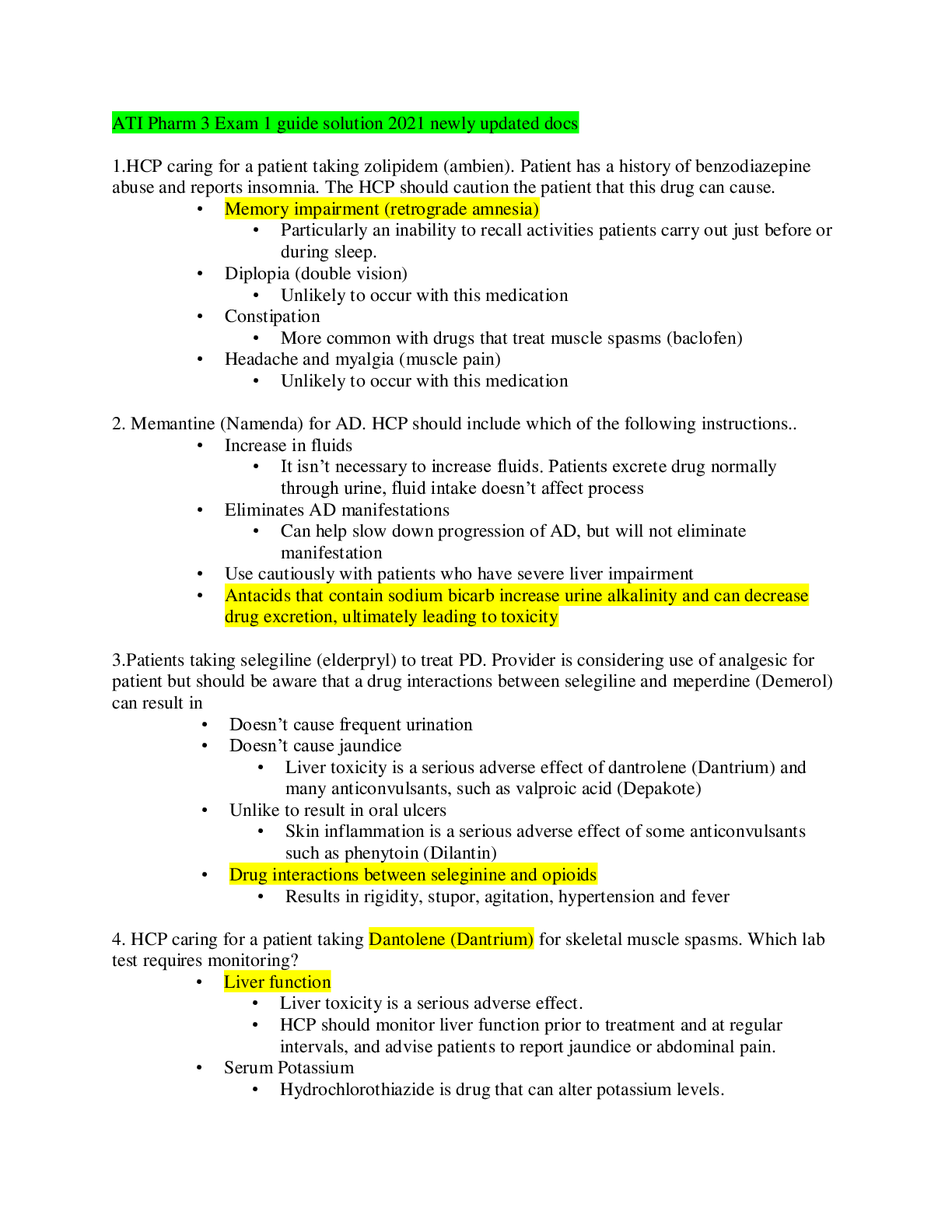
Reviews( 0 )
Document information
Connected school, study & course
About the document
Uploaded On
Feb 02, 2021
Number of pages
12
Written in
Additional information
This document has been written for:
Uploaded
Feb 02, 2021
Downloads
0
Views
32

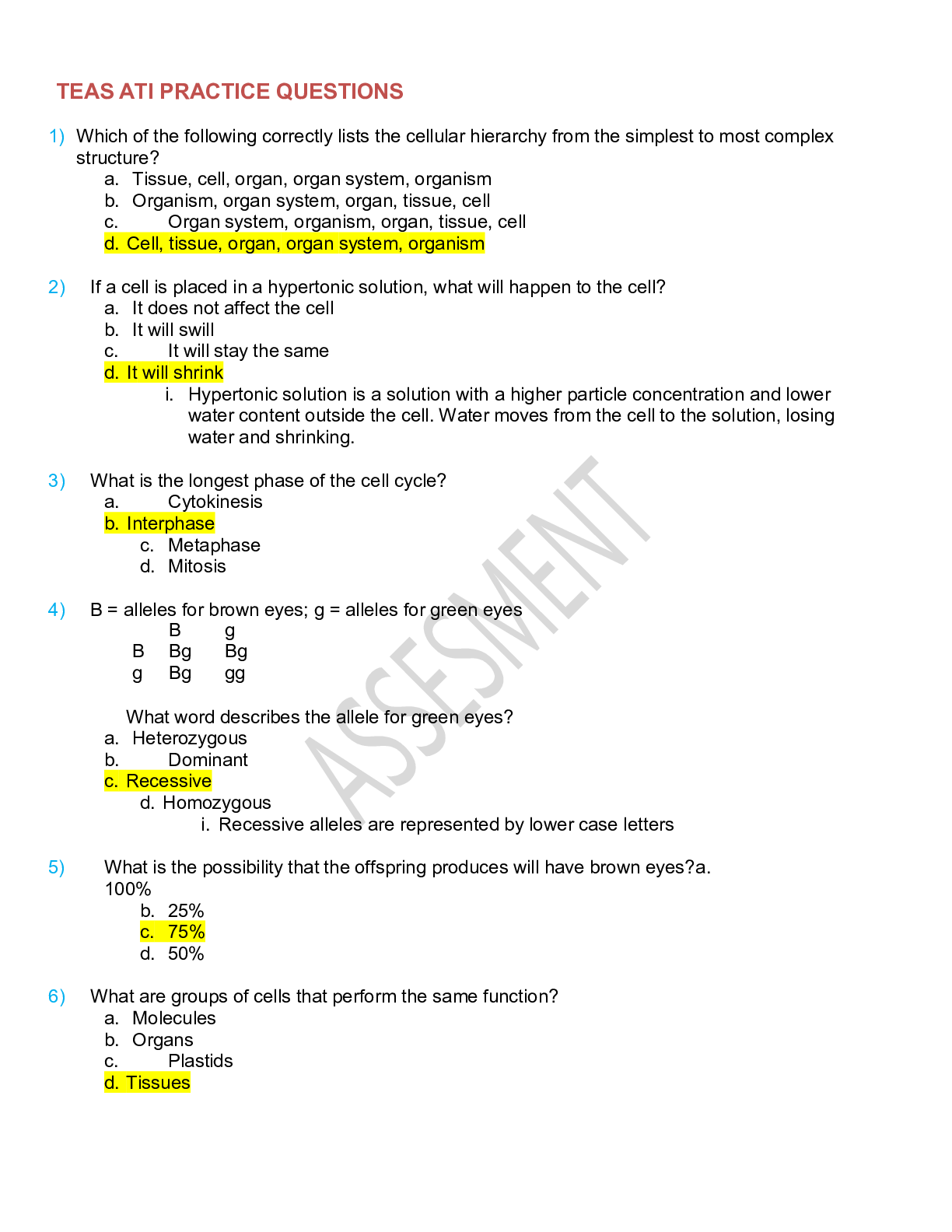

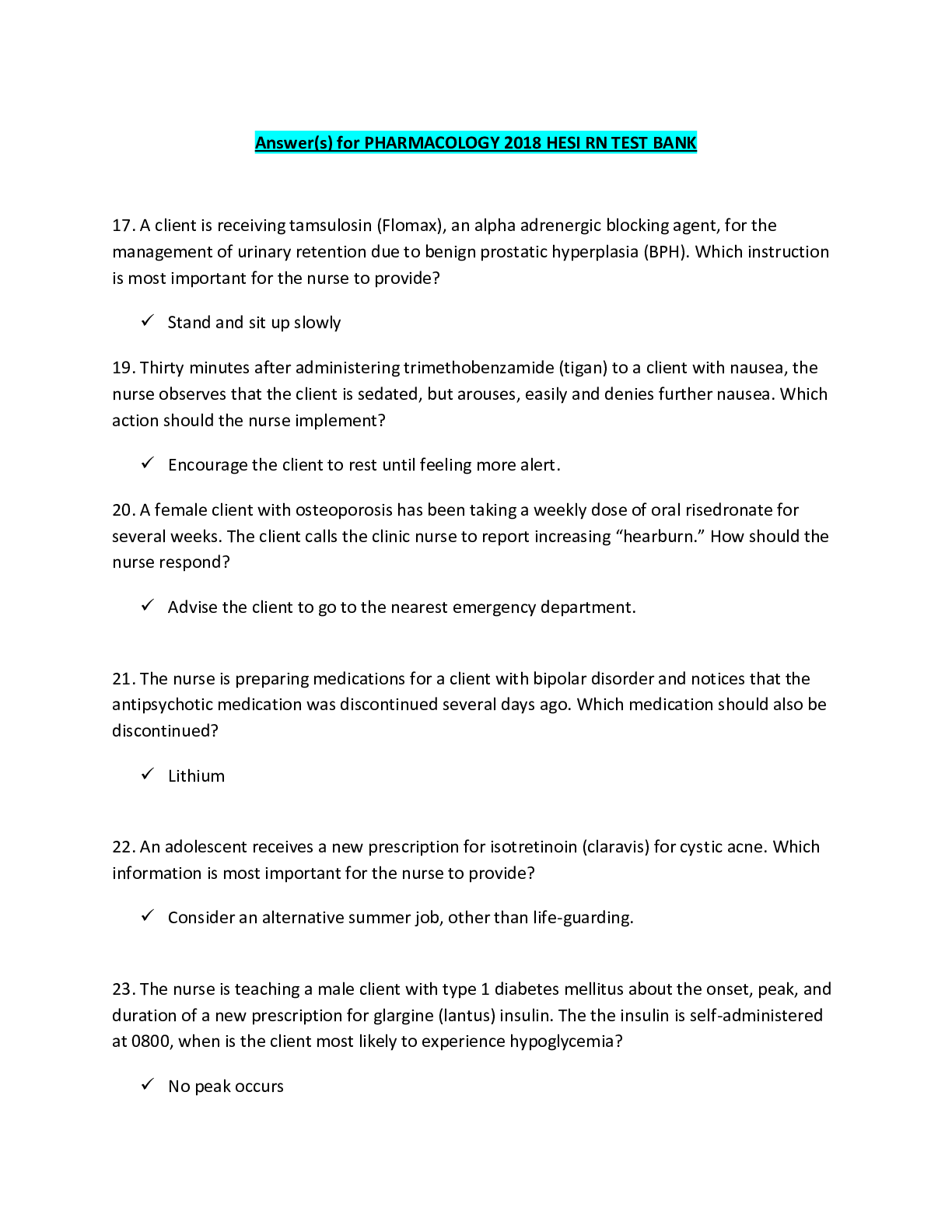


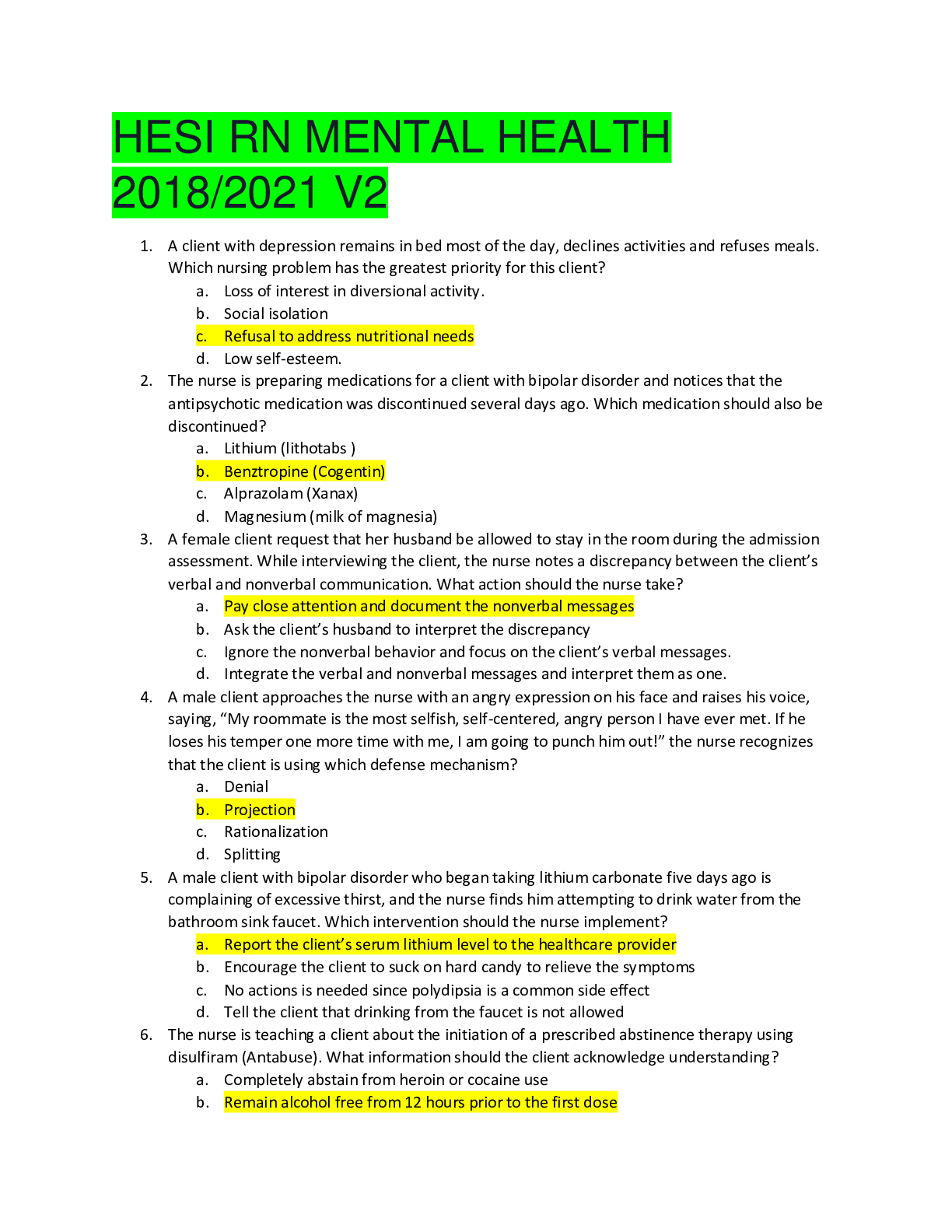

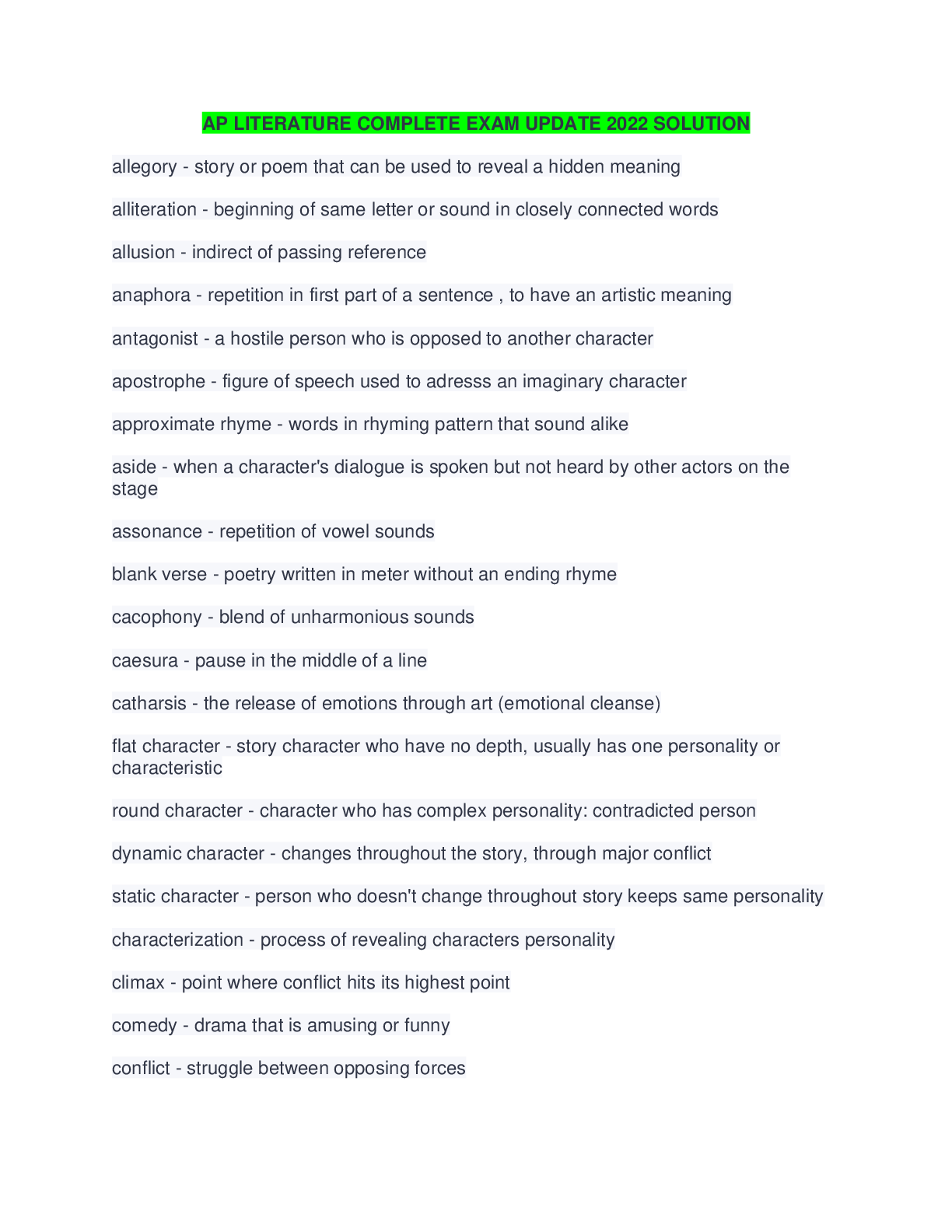

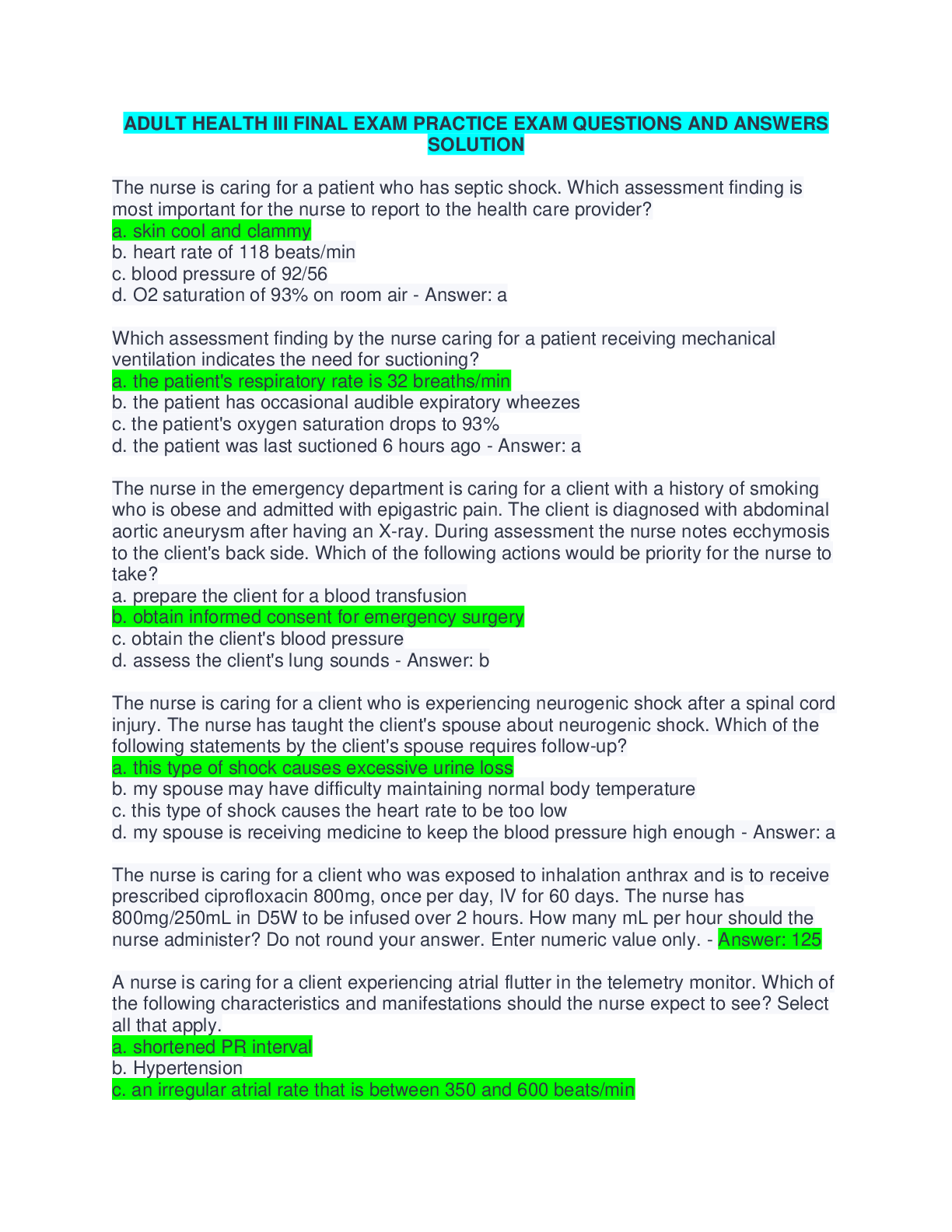

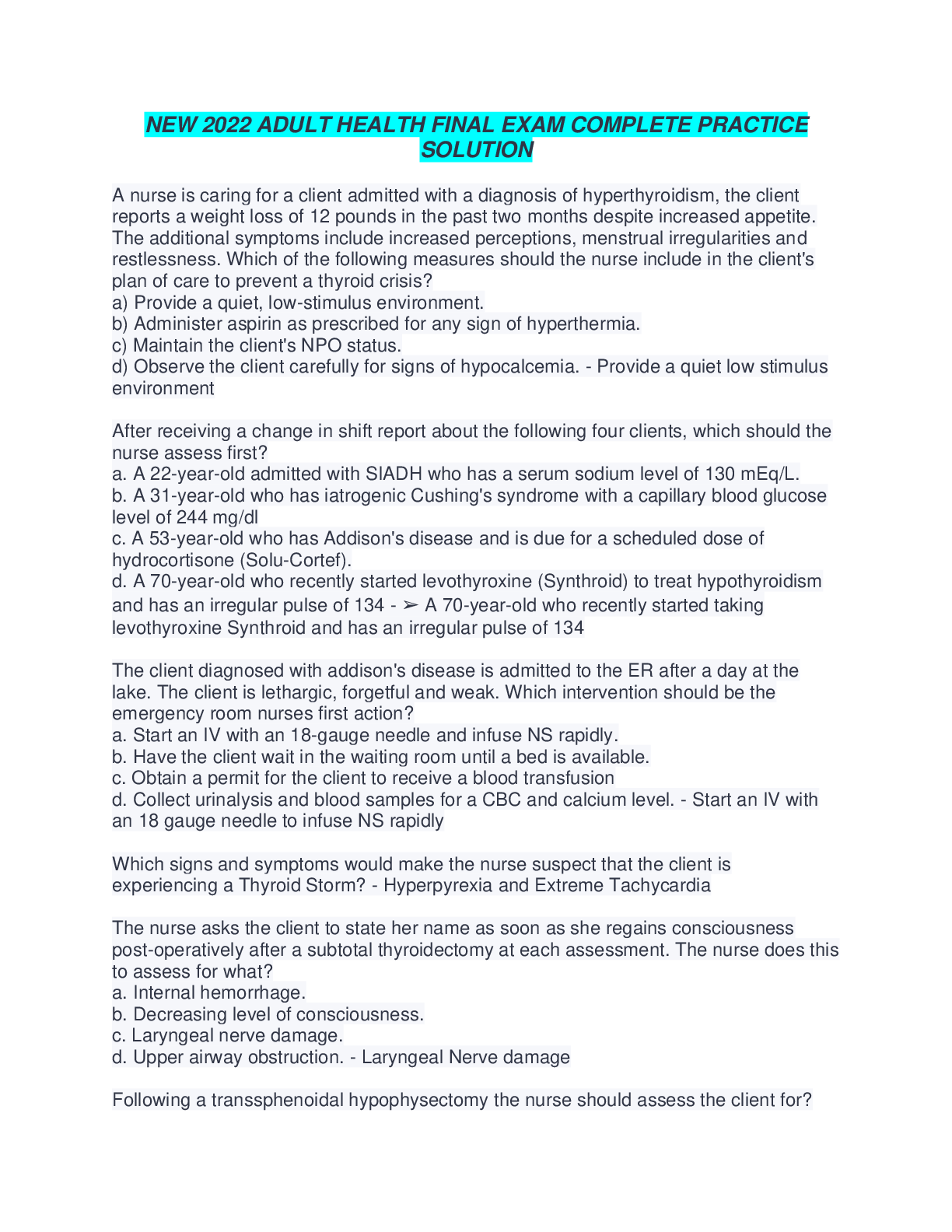
 GRADED QUESTIONS AND ANSWERS.png)



